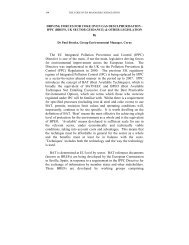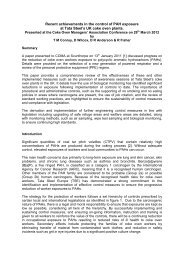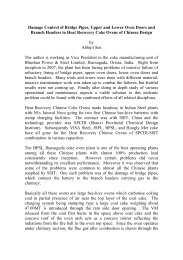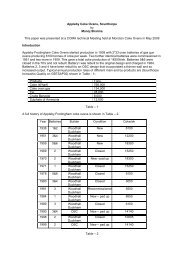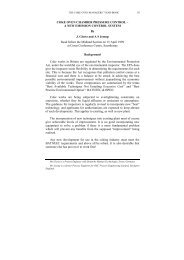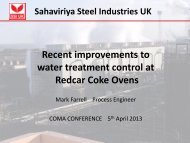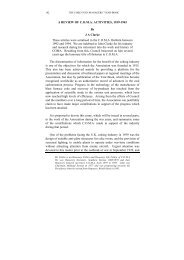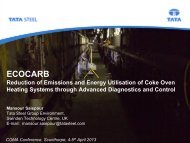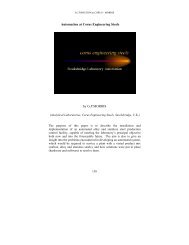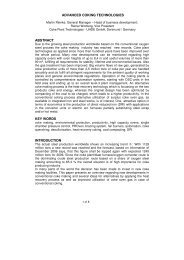CHAIRMAN'S ADDRESS - Coke Oven Managers Association
CHAIRMAN'S ADDRESS - Coke Oven Managers Association
CHAIRMAN'S ADDRESS - Coke Oven Managers Association
- No tags were found...
Create successful ePaper yourself
Turn your PDF publications into a flip-book with our unique Google optimized e-Paper software.
70 THE COKE OVEN MANAGERS’ASSOCIATIONon: ‘It is said there are some expanding or salt-containing coals for whichparallel walls are unsuitable, but do not believe it. Tapered ovens are a relic ofthe days when, owing to uneven heating, ovens could not be pushed, and somebrilliant genius thought that by giving a 2-inch taper in 400 inches he wasdoing something to win the war (among coke oven contractors)! There are a lotof things like this lurking about coke ovens, some of them in very unexpectedplaces.’ It is worth noting that these ovens were still being built with an archedroof to the chamber. The surplus gas was to be supplied to a power stationabout 2 km away 66 .According to a later account 103 , these Simplex ovens had ‘two sets ofwalls’, i.e. each chamber had its own pair of heating walls, not shared with theadjacent chamber. This is the only mention of such an arrangement found bythe present writer at Simplex plants; it was of course typical of Semet-Solvayovens. From 1919 to 1938 inclusive, the Simplex battery (constructed of semisilicabrick) carbonised some 38,000 tonnes of coal per chamber, at an averagegross carbonising time of 31¼ hours, the oven charge being just over 8 tonnes.The author of that later account stated in conclusion that ‘the Simplex ovenwas probably as good as any of its day.’To replace the Simplex and Semet-Solvay ovens, Lambton had twobatteries of 30 Collin ovens built in 1935 and 1938, themselves replaced in1955 by 52 Coppée ovens for the owners since 1947, the National Coal Board.The plant was finally closed in 1985/6.TrehafodThe Simplex installation here in 1920 represented a backward step from thegeneral advancement of cokemaking technology, with its horizontal-flue,waste-heat ovens having chambers only 2.3 m high and taking only 7 tonnes ofcoal, charged through three holes from individual tubs, and with a central gasofftake 58 . The 40 ovens, in a single battery, carbonised 1500 tonnes of coal perweek, at a carbonising time of 29 hours. The waste heat was utilised by fiveLancashire boilers.The article 58 describing this plant makes no mention of any battery that itreplaced. The evidence for an earlier regenerative battery of 50 ovens (initially40, it seems) is from a Simplex advertisement already mentioned (CollieryGuardian, 26 November 1909) and the published lists of coking plants 3,45,83 .The article also fails to mention the 40 B.C.O. waste-heat ovens built duringWorld War I by British <strong>Coke</strong> <strong>Oven</strong>s Ltd (whose only other ovens were at



